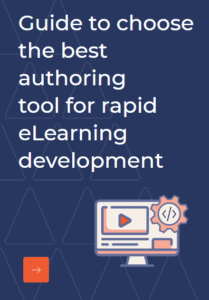According to PEW Research, “As of 2017, 77% of US adults own a smartphone, up from 35% in 2011.” Another study points out that we are obsessed with our mobiles and the heaviest smartphone users click, tap or swipe on their phone 5,427 times a day, according to researcher Dscout. Even the moderate users touch the addictive devices 2,617 times a day on an average.
Some numbers, right!
It is no wonder that the Mobile Learning Industry has evolved over the years. Popularly termed as mLearning to encompass the entire range of devices that it caters to, the design, development of deployment of mLearning too has changed a lot over the years. And the best part is that we no longer have to opt for the lengthy process of mobile content creation, thanks to the unlimited pool mobile learning authoring tools.
Here are our top picks:
Adobe Captivate (2017 release):It simplifies the process of creating mobile learning courses that too for the multi-device environment. It highly reduces the authoring time with the innovative new Fluid Boxes that use white space optimally to align objects automatically. And what’s more? You can easily transform the existing Adobe Captivate desktop-only courses into fully responsive mobile learning content and even customize them. This is one of the highly popular tool amongst the enterprise who already have experienced the Adobe suit earlier.
dominKnow:dominKnow offers three types of outputs for mobile eLearning and lets you publish the courses as HTML5-using web-apps. Flow outputs fully responsive and adaptive content, while Claro designs fixed layouts for HTML5 based devices, scalable for various screen sizes. It comes pre-loaded with mobile layout templates to help speed mobile course development.
Articulate Storyline 3: Now that’s a popular name and rightly so. Its new version is a wonderful tool to develop mLearning courses. The Articulate Mobile Player delivers great learning experiences on mobile devices.Learning can be created either as native iOS app for iPads, or, using HTML5, as a web-app as well.
Key highlights:
- Recreates effects similar to Flash
- Integrates with Tin Can API
- Simple interface
- In-built interactivities and character library
Lectora Inspire 17: Yet another rapid authoring tool, Lectora Inspire 17 makes creating multi-device courses easier. It is ideal for converting text-heavy content into mLearning courses. It comes with applications - eLearning Brothers-Lectora Template Library, Cutout People Library and Interaction Builder, BranchTrack for easily creating branching scenarios and Snagit 13 for Screen captures. It also allows to publish the content to mobile devices both online and offline.
iSpring Presenter: Now iSpring Suite 8 is a useful authoring tool for converting presentations into online mobile courses. Courses created run seamlessly on smartphones (with Windows, iOS, and Android OS).
It comes with a wide variety of publishing options- HTML5, Flash, and .exe formats, ZIP archives and to the Web.
All the tools listed above allow to publish to AICC, SCORM compliant Learning Management systems (LMSs) and can be integrated with Tin Can API too.
Selection of the authoring tool is often influenced by the learning requirement, the devices, timeline and budget. With each year, we get newer authoring tools with improved features. The key is to make a calculated decision by comparing the pros and cons.
Which other tools should we add to the list? Do share your opinion.


